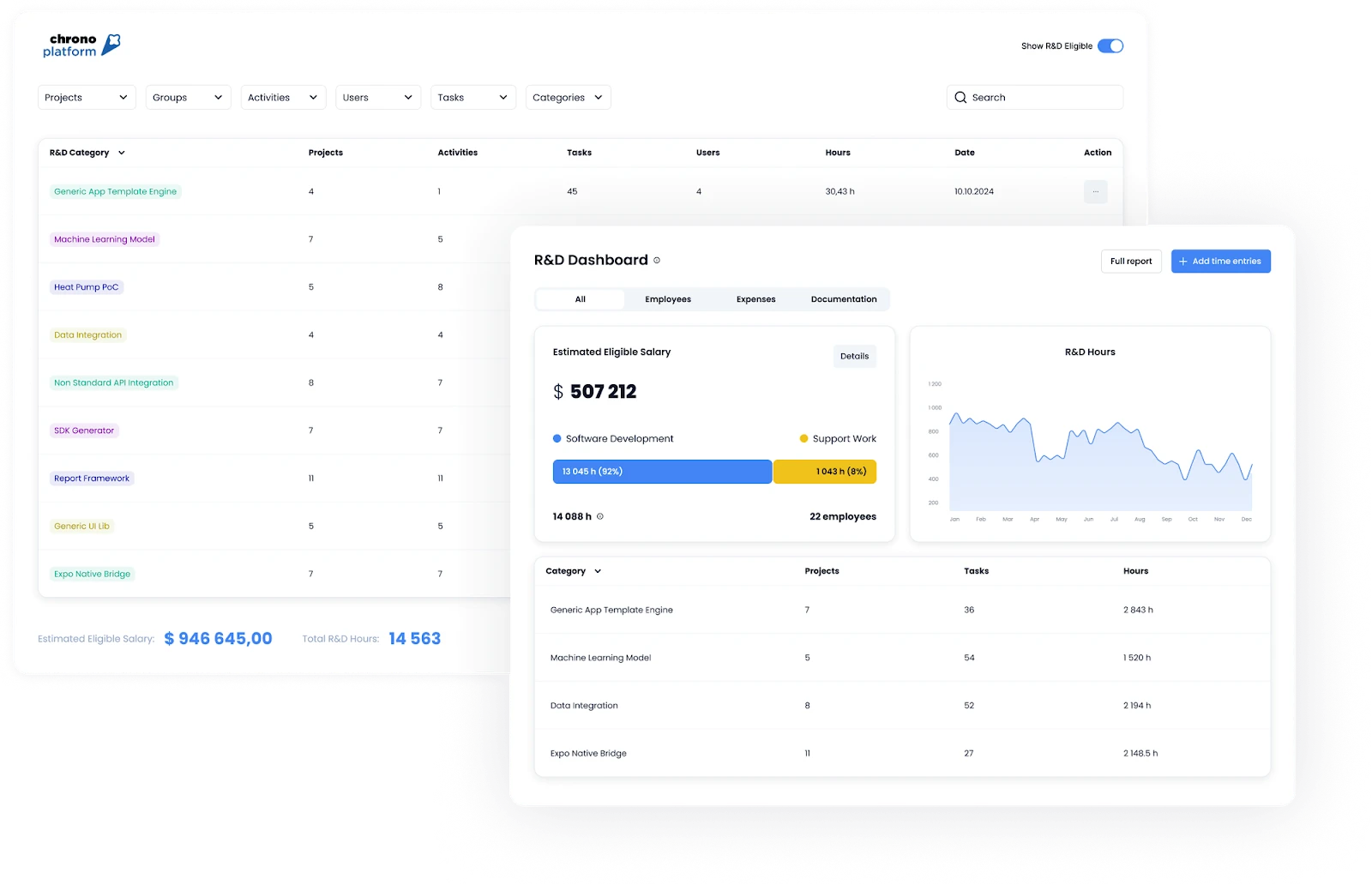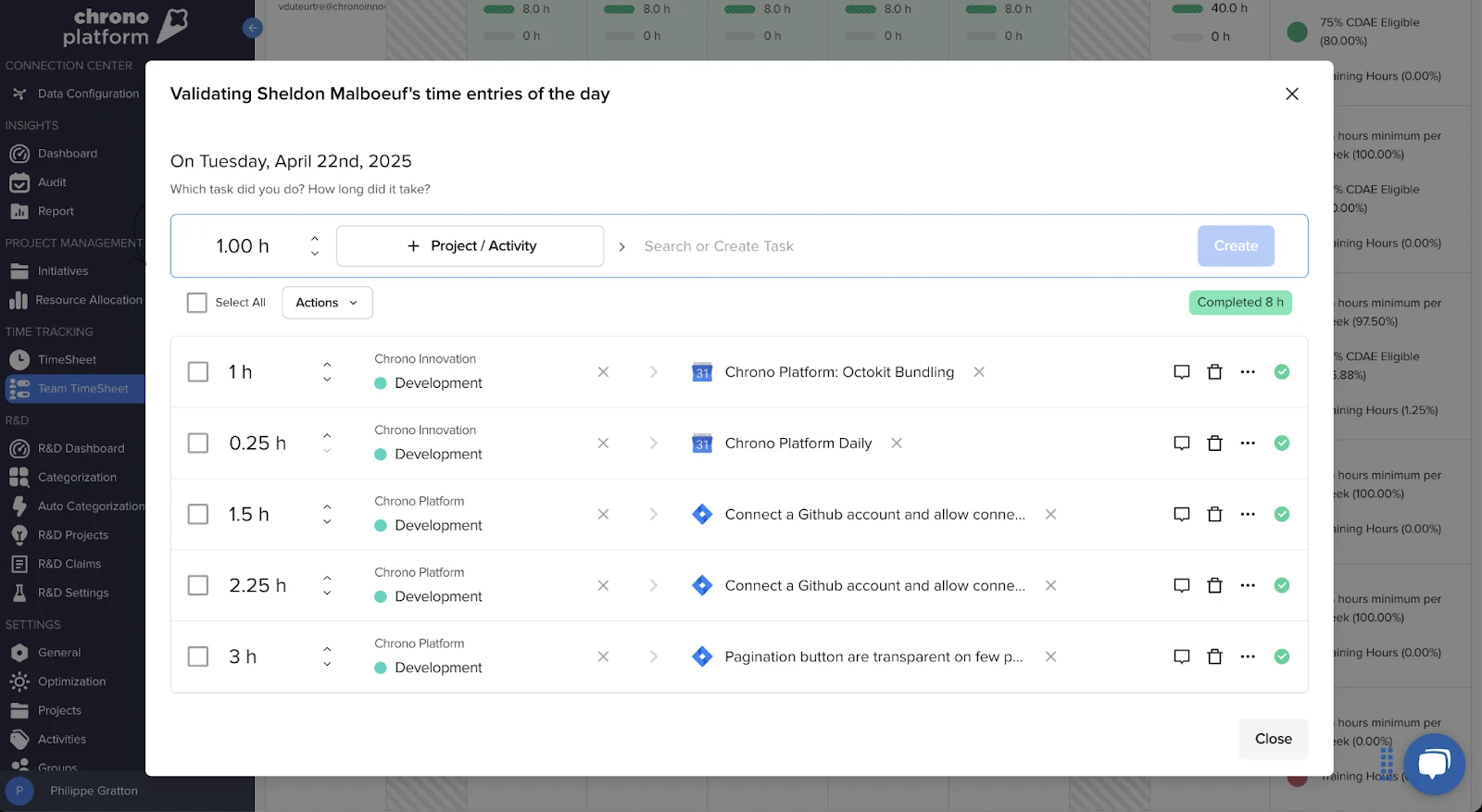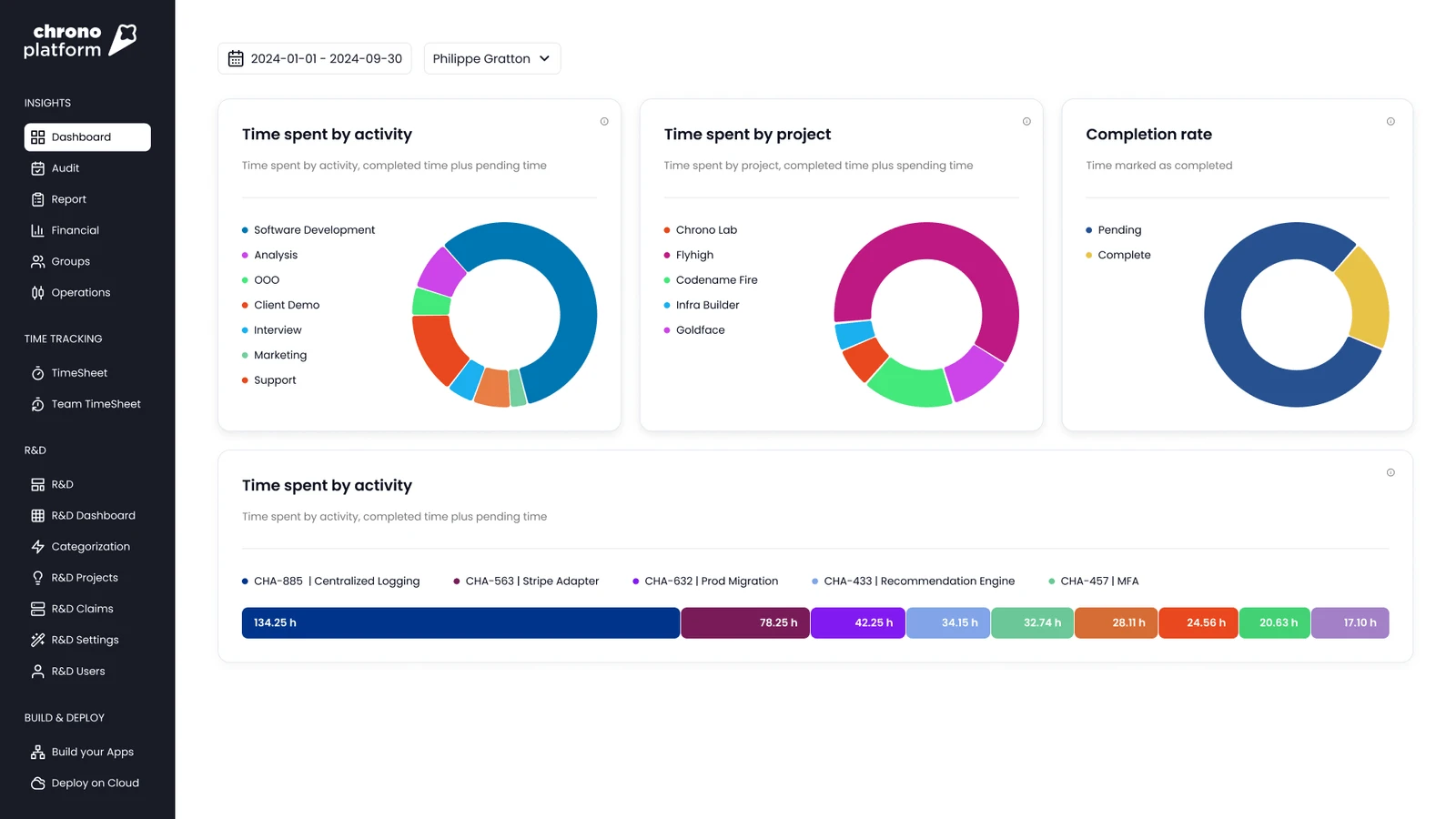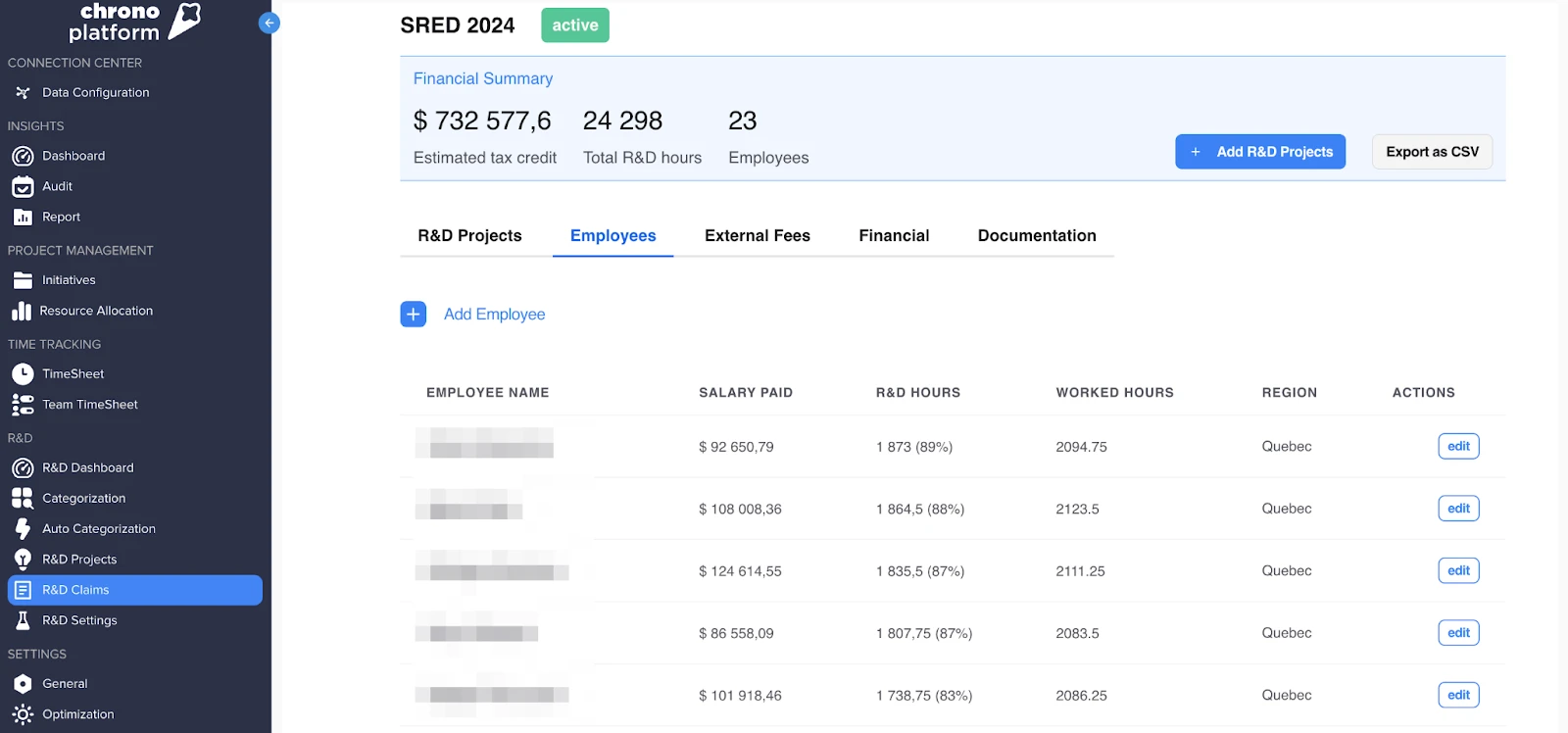Sprint Planning Template: A Practical Guide for Modern Engineering Teams
Plan smarter, move faster. Get your sprint planning on track with our practical temp

Accurate forecasting defines how well your engineering team delivers. Yet, planning each sprint still feels uncertain when your metrics sit in different tools. Besides, capacity calls should rely on how work, time, and budgets actually connect.
You’re on the right page to improve your planning.
In this article, you’ll see how using real engineering data and a clear sprint planning template will help you plan sprints with confidence and precision.
And yes, there’s a free downloadable sprint template for you below.
But let’s start by remembering the basics.
P.S.: Before we dive in, here’s a quick way to make your planning data actually work for you: Chrono Platform connects your sprint tools into a single dashboard so you can forecast with confidence, trace progress to financial outcomes, and stay audit-ready by design.
What Is Sprint Planning?
Sprint planning is the process where you define what your team will deliver and how much work fits into the next sprint. It’s a structured conversation that aligns engineering capacity, product priorities, and delivery goals. During this session, you translate roadmap objectives into actionable tasks your team can commit to with confidence.
This short video gives you a clear overview of what happens during sprint planning in Scrum:
The truth is that accurate planning depends on data. But having a clear picture of your capacity is not enough. You also need to know how to protect your capacity.
If predictability, quality, and speed are your goals, make sure every estimate reflects real capacity and past performance.
That’s why you need a sprint planning template and a clear agenda: they make the entire process consistent and measurable.
That brings us to the next point:
Sprint Planning Meeting Agenda
A structured sprint planning meeting starts with a clear objective for the sprint. It’s followed by a discussion of available capacity and priorities from the backlog. You define what success looks like, assess workload balance, and confirm that the commitments match your team’s actual bandwidth.
Yet many teams still struggle to stay organized during this stage. Only 37% of meetings follow an agenda, even though sprints demand one to stay focused and avoid wasted hours.
Also, capacity planning usually creates another challenge. McKinsey found that 46% of teams try to fully book their capacity during sprint planning, which typically leaves no room for unexpected work.
That’s why defining a clear sprint planning agenda matters. It sets the stage for realistic forecasting and measurable outcomes, which we’ll look at next.
Sprint Planning Benefits
Strong sprint planning is how you keep engineering predictable, align delivery with financial targets, and create a clear link between effort and business value. When planning is backed by accurate data, it becomes a foundation for better forecasting, faster releases, and stronger collaboration. So, here are the benefits of sprint planning.
Better Sprint Planning Strengthens Forecasting and Delivery
Consistent sprint planning helps you forecast with accuracy. When you compare historical velocity with actual capacity, you prevent overcommitment and manage expectations across teams.
This is how you turn sprint goals into reliable delivery outcomes. The result is fewer late releases, more consistent throughput, and improved trust between engineering, product, and finance.
Data-Driven Planning Improves Productivity and Team Morale
Balanced capacity reduces burnout. When the workload matches actual bandwidth, developers focus on quality instead of rushing to meet unrealistic targets. Managers gain better visibility, and finance teams see predictable resource use.
In the long run, these improvements build momentum. Meanwhile, your teams complete more work without extending hours, and planning sessions shift from stressful debates to productive decisions.
Sprint Data Links Engineering Work to SR&ED and Compliance
Accurate sprint data also builds the foundation for credible R&D reporting. Every ticket, commit, and tracked task becomes evidence of engineering effort that can be linked directly to SR&ED eligibility. This turns routine project data into reliable documentation that satisfies audit standards without added admin work.
Chrono Platform’s SR&ED automation connects your sprint metrics, time entries, and development activity to the financial side of your business. It automatically identifies SR&ED-eligible work and organizes it into audit-ready records.
This gives you a clear view of how engineering output contributes to claimable R&D investment. The result is transparent, compliant reporting that supports both operational and financial accuracy.

Next, you’ll see how a sprint planning template brings these ideas into a repeatable format that scales with your team.
What Is a Sprint Planning Template?
A sprint planning template is a structured tool that helps you organize sprint goals, assign tasks, and plan work based on your team’s real capacity. It captures velocity, workload distribution, and available hours to make each sprint forecast measurable and repeatable.
In Agile sprint planning, using a template ensures that every commitment aligns with both engineering capacity and business priorities.
Below, we have for you a downloadable sprint planning template designed to help you set clear goals, manage team capacity effectively, and bring consistency to every sprint cycle.
Sprint Planning Template (Downloadable)
This downloadable sprint planning template gives you a ready-made structure to plan sprints with data clarity. It helps you track capacity in real time and keep delivery goals aligned across teams.
How to Use Our Sprint Planning Template
This template gives you a practical framework to plan sprints based on real data rather than assumptions. It’s built for teams that want to track capacity, forecast delivery with precision, and maintain visibility across engineering, product, and finance.
Let’s go through how each part works and how you can adapt it to your team’s size and workflow.
Sprint Overview
Here, you define the sprint goal, link it to higher-level epics, and record your team’s average velocity from the last few sprints. That velocity value sets the baseline for how much work your team can realistically commit to. If your team’s average completion rate is 80 story points, planning for 120 will immediately put you behind.
Team Capacity Planning
This section converts availability into measurable capacity. Each member’s working hours, role, and allocation percentage combine to show how much effort the team can deliver. Keeping the planned workload at 80-85% of total capacity leaves room for unplanned work or urgent issues. This is a common buffer used by high-performing teams.
Sprint Backlog Selection
Each task has its own estimation, owner, and dependency field. This ensures alignment between workload and capacity before the sprint even starts. Over time, tracking how actual completion compares to these estimates helps you refine planning accuracy.
Risk & Alignment Notes
Here, you log blockers, cross-team dependencies, and SR&ED-eligible work before the sprint starts. Each line has an owner and a deadline, so accountability is clear. Tag research or experimental tasks early so Chrono Platform can trace them automatically for SR&ED compliance.
Sprint Review Metrics
This part closes the loop by turning results into data. You track committed vs. completed story points, cycle time, throughput, and carry-over rate. These numbers show how predictable your sprints are and where to adjust planning for the next one.
How to Adapt It for Team Size and Project Type
Smaller teams can merge capacity and backlog sections into one table to simplify visibility. Larger, multi-squad environments benefit from splitting the template by functional role (frontend, backend, QA) so you can see utilization patterns.
For research-heavy projects or those involving SR&ED-eligible work, you can use the SR&ED column to tag experimental tasks early. This makes compliance reporting faster later. Now, you can download the template to start using it immediately.
But here’s where the process scales.
Chrono Platform’s SR&ED automation syncs your sprint data in real time, classifies eligible work automatically, and builds audit-ready documentation as you plan. That means the same sprint data that drives delivery also supports your financial and compliance reporting.
Common Sprint Planning Challenges
Even the most experienced teams struggle to keep sprint planning accurate and consistent. Problems typically arise when planning relies on assumptions instead of data, or when different departments track progress in isolation.
Well, to help you avoid that…
We’ve compiled four challenges that can weaken your process and how you can start addressing them. You can understand them now and avoid them in the future.
Overcommitment Means Developer Burnout
Overcommitment happens when sprint goals exceed the team’s real capacity. It’s easy to fall into this trap, especially when past performance isn’t measured or discussed openly. If you do that, you’ll notice long hours, missed deadlines, and falling morale.
Recent data reflect how common this problem is.
A 2025 report found that 52% of developers cite burnout as a leading reason for peers leaving their jobs. Meanwhile, 23% work overtime at least 10 days a month.
That’s why tracking workload through real capacity data is important. This includes available developer hours and historical throughput. With Chrono Platform, this visibility is automated, so you can adjust before burnout sets in.

Manual Tracking Means Inconsistent Data
Manual tracking in spreadsheets or disconnected tools typically leads to outdated or inaccurate sprint data.
Studies show that manual tasks carry error rates between 0.55% and 4.0%, depending on the context. Those small errors compound quickly across multiple inputs. That’s why automated tracking is important.
Pro tip: Even after you implement automated tracking, you need to focus on the genuinely useful metrics, like cycle time, throughput, and resource allocation.
Without these reliable metrics, you can’t evaluate performance or identify process bottlenecks. This makes it difficult to compare sprint results over a longer duration or make evidence-based decisions.
Lack of Alignment Between Engineering, Finance, and Product
When teams plan sprints in isolation, misalignment spreads fast. Engineering commits to certain delivery goals, product adjusts priorities mid-sprint, and finance struggles to understand where time and money go. This lack of shared visibility increases operational risk.
Luckily, there’s a way to easily avoid this.
Chrono Platform connects engineering metrics with financial and product data so each team sees the same capacity forecast, progress indicators, and cost breakdowns. Alignment improves decision-making and keeps all departments working toward the same outcome.

Weak Connection to R&D and Financial Reporting
Sprint data serves an operational purpose but also influences financial outcomes. When time spent on research and development isn’t properly documented, companies lose potential SR&ED tax credits.
Each of these challenges can be solved with a consistent structure and smarter data use. Next, you’ll see the best ways to improve planning discipline and create more predictable sprint outcomes.
Sprint Planning Best Practices
Even with the right tools, sprint planning can lose focus without structure or reliable data. These best practices help you run efficient meetings, improve team coordination, and plan sprints that reflect real capacity and lead to predictable outcomes.
If you’re more of a visual learner, here’s a practical walkthrough of how sprint planning should work in real teams:
Keep Meetings Short and Structured
A focused meeting saves everyone’s time. The Scrum sprint planning framework defines a clear timebox: up to eight hours for a one-month sprint, and proportionally less for shorter cycles.
In practice, many teams prefer a more compact format. For example, FlowLu suggests about 45 to 60 minutes for a one-week sprint.
The goal is to align scope and capacity without getting dragged into side discussions. Preparing with the right data beforehand, such as velocity trends, backlog priority, and available hours, will keep meetings productive and actionable.
Use Data
Documented information, such as user stories, dependencies, and acceptance criteria, plays a crucial role in estimation.
In a global survey, 98% of Agile practitioners said these details are important for accurate effort planning. When this information is updated automatically, teams make decisions faster.
Involve the Whole Team
Shared understanding begins with shared participation. In a study on Agile team estimation practices, researchers found that estimates created together reduce rework and confusion. When everyone contributes, effort estimates are grounded in firsthand knowledge.
This is also how you surface risks early (e.g., technical dependencies or competing priorities) before they impact delivery.
Besides, collaborative estimation builds stronger accountability and alignment between your engineering and product teams.
Leave Buffer for Unplanned Work
No sprint runs exactly as planned. As we advised you above, leaving space for unexpected work helps maintain predictability.
In fact, FullScale’s analysis shows teams that commit to about 85% of their total capacity achieve roughly 40% higher sprint success rates than those that plan for 100%. That margin absorbs last-minute changes, blockers, or production issues without derailing progress.
These practices work best when supported by the right integrations and automation. So, let’s cover that next.
Sprint Planning Tools & Integrations
Running an effective sprint depends on the right systems working together. The tools you use to plan, track, and analyze sprints determine how accurate your forecasts are and how easily that data connects across engineering, product, and finance.
Jira Sprint Planning Basics
Jira remains the most widely used tool for sprint management. It helps you organize work through boards, backlogs, and burndown charts. In practice, Jira’s real strength lies in visibility. It shows how tasks move through each sprint and how that progress relates to velocity and capacity.
However, many teams outgrow Jira’s default reports once they start focusing on forecast precision or financial alignment. This is where integrations and add-ons become important for refining sprint capacity planning and improving collaboration across teams.
Common Add-ons and Integrations
To make Jira more powerful, many teams add tools that improve planning accuracy, automate workflows, and connect sprint data across systems. Each of these tools helps you manage capacity, visibility, or reporting with less manual effort:
- Tempo Planner / Tempo Timesheets: These tools link time tracking and resource management to sprint data. This makes it easier for you to monitor utilization and availability.
- BigGantt / BigPicture: These add-ons provide timeline and Gantt-style views that help visualize dependencies, progress, and long-term planning.
- Pivot Report for Jira: This reporting tool creates custom reports and pivot-style tables to give you deeper insight into sprint metrics and issue data.
- Easy Agile User Story Maps: This integration helps you organize stories visually so backlog prioritization stays aligned with product goals.
- JMWE (Jira Misc Workflow Extensions): This extension automates repetitive workflow tasks, transitions, and conditions to maintain data consistency.
- Jira + Confluence Integration: This connection lets you embed requirements, design documents, and acceptance criteria directly into Jira issues for stronger context.
- Issue Link Viewer: These tools display relationships between issues to help you identify hidden dependencies before a sprint begins.
- Slack / Microsoft Teams Integrations: These integrations send automatic notifications for sprint updates so stakeholders stay informed in real time.
- API / REST Integrations: These connections allow Jira data to flow into business intelligence, compliance, or financial systems for centralized reporting and analytics.
Chrono Platform: Connecting Sprint Data to Compliance and Financial Insight
Chrono Platform connects your engineering activity with compliance and financial visibility. It captures real-time sprint data from tools such as Jira, Asana, and Slack, then translates it into structured metrics for planning accuracy and SR&ED automation.
Each sprint becomes traceable to its financial and operational impact and gives you full transparency from commit to claim. Chrono Platform eliminates manual data gathering and makes every sprint audit-ready by design. This helps your team plan confidently and report effortlessly.

Build Predictable Forecasting with Chrono Platform
Accurate forecasting starts with visibility you can trust. At Chrono Platform, we turn engineering data into real-time insight that helps you plan confidently, balance capacity, and align every sprint with your business goals.
Our platform bridges engineering, finance, and product decisions so leaders see the full picture, from resource use to delivery impact. We help you move beyond guesswork and create measurable predictability across teams.
When your data flows seamlessly, forecasting stops being an estimate and starts becoming a reliable business asset.
So, sign up to Chrono Platform for free and start turning your sprint data into accurate forecasts, transparent reports, and audit-ready documentation that strengthen every delivery decision.
FAQ
How to structure sprint planning?
Start with the sprint goal, then define the backlog items needed to reach it. Review capacity and velocity to confirm what’s realistic. End by assigning ownership and setting measurable outcomes. A structured flow keeps your sprint predictable and aligned with business priorities.
Which tool is best for sprint planning?
Jira is the most common choice because it connects tasks, capacity, and reporting in one place. Many teams use it as their core project hub, but still struggle to track real-time performance or link work to measurable outcomes. Chrono Platform can help you because it integrates with Jira, Asana, and other tools to help you automate metrics and improve accuracy without changing your setup.
How to design a sprint plan?
Start by defining clear sprint goals based on your product priorities and team capacity. Break the work into specific, achievable tasks with estimated effort for each. Review the plan with your team to confirm workload balance and adjust before starting the sprint.
Can we do sprint planning in Jira?
Yes. Jira supports backlog organization, capacity tracking, and sprint analytics. With Chrono Platform, this data updates automatically and gives you live metrics that strengthen both delivery and SR&ED reporting.



